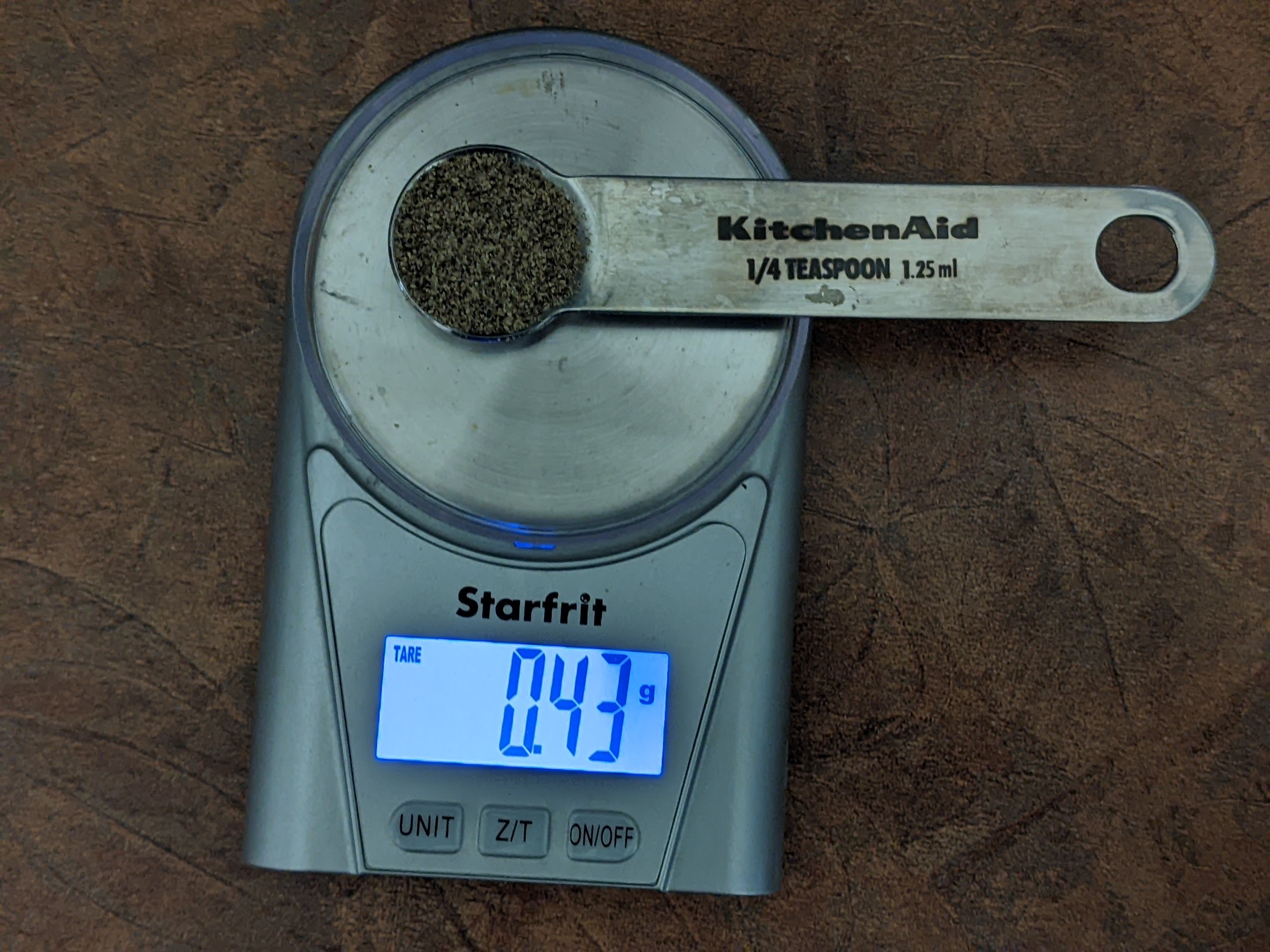I’m tired of guessing which country the author is from when they use cup measurement and how densely they put flour in it.
If you bake regularly then this is a popular opinion. I generally won’t bother with a recipe that does not have the weights.
What, I’m supposed to use my kitchen scale for something other than cocaine?
Scale, fancy. I just keep going until the feelings disappear.
You’re doing it right. The scale is for selling not measuring doses.
I’m of the opinion that if you’re good at what you do, you should be able to eyeball all the ingredients. You shouldn’t need exact measurements to be able to tell if you’re using enough if you know what you’re doing.
Of course, very experienced people made the recipe by eyeballing, but there was probably still trial and error to get to the desired result. But I don’t have time for this when I’m trying to bake a birthday cake for my son.
Downvoted for popular opinion.
I am a proficient baker and I can get behind this.
“One pound of milk”
454 ml! Because 1 gram of water is also 1 milliliter.
Density of whole milk according to first google answer is 1,034g/cm^3.
It’s been a while, but would that make it 438,68 ml?
Edit: But I totally agree with your statement. SI/ metric units is superior in every way with how easy it is to convert between them. At university in Norway I had American textbooks in all but one of my chemistry classes and all used SI/metric and proper names for the elements
yes. It’s far easier to measure liquids by mass accurately
I’ve never seen a commercial scale that didn’t measure Grams and Lbs. Really common stuff.
It might be more of a concern for industrial scales, but I’m sure industrial food processing use Weight for all their ingredients already.
Cleanup is so much easier also. I don’t have to use a measuring spoon or cup for ingredients—I just dispense them into the bowl until I hit the correct number.
Overshoot? Then what, scrape the flour out from the sugar?
I have done this many times. But I also got better at not overshooting.
You weigh ingredients in one bowl and pour into your mixing bowl. You still end up washing less
Fair enough
I use 25 lbs bags of flour but I’m sure I could manage.
Just because no one in your life cares enough about your niche opinion to actually have an opinion does not make that an “unpopular opinion.” When your opinion is the opinion of hobbyists, professionals, and elites alike, it’s certain not unpopular, even if it is niche.
You’re certainly right in your opinion, and that’s the point of bitching at you.
OP is probably from Western Europe, where a kitchen scale is common. Ain’t nobody in the US got a fancy kitchen scale.
The solution to their problem is use mL for volume.
Technically oils and milk are lighter per volume than water so the mL to g conversion doesn’t really work. mL only equals g of water, specifically.
I wasn’t thinking about conversations, only picking a standard. A mL is a mL no matter where you are in the word.
deleted by creator
Ain’t nobody in the US got a fancy kitchen scale.
Lots of us have them. (Well, basic scales which weigh a tenth of a gram.) They’re useful when weighing compressible dry ingredients like flour and brown sugar, and viscous wet ingredients like molasses and corn syrup. They’re also helpful when you’re multiplying a recipe by a factor that doesn’t result in useful units; it’s annoying to figure out how to measure out fractional cups that involve teaspoons.
They also help with portion control if you’re watching calories.
I have had two different well-recommended scales for baking and neither does a good job measuring 1-3 grams of ingredients. Maybe I just need to spend hundreds of dollars I don’t have on some pampered chef thing….
I do have what we call the “drug scale” in our house. It can measure to 0.01g but its capacity is so low it is useless for baking. I don’t want to weigh my baking soda badly enough to get it out.
“coffee scales” are good for gram scale quantities
I have one like that that goes up to 400g I think. I tried using it for measuring my creatine powder once but it wasn’t sensitive enough. Trying to cook with it seems like it would be a pain in the ass unless I was making huge batches of stuff.
This isn’t unpopular.
Anyone who learns to bake quickly learns this.
Anyone who learns to bake knows that’s silly. You don’t need to try and weigh out a teaspoon of vanilla or that 1/4 cup of sugar weighs exactly X amount.
Use non-American recipes.
The rest of the world does this. And guess what, 1 milliliter of water is exactly 1 gram, unlike stupid ounces.
a millilitre of water is a gram, dog
Geez, you and the other commenter have good timing. It was a temporary edit to mess with an active commenter. Started as gram 😉
1 mL water is 1 gram
Hah, that was a temporary edit to mess with the other commenter 😉 Good timing for you I guess.
If I want a recipe in English I always end the search query with “UK” to make sure it’s in weight, not cups. I’m not a fucking toddler
I try that too for English recipes but then I get things in tablespoons, teaspoons, pinches, good pinches, full pinches, and small bunches.
Or my favorite “a good knob of butter”
At least they aren’t using stone for flour though lol.
Density differs for other ingredients though.
It does, but I would still rather use grams usually. My ice cream base recipe says 500g skim milk and 470g heavy cream. I don’t have to get a measuring cup dirty—I just pour them into the bowl.
That’s more an issue of its too hard for you to learn, then. Also, for cooking, that’s great that 1ml of water weighs 1mg. Why does that help with cooking? All the weights of everything else will be different from that. It’s much quicker and easier to use a measuring cups to get half a cup of flour than it is to get a scale and weigh out 60 grams.
it’s much quicker and easier
Ask any boulanger or pâtissier how to do shit baking lol
A fluid ounce of water is an ounce of weight
Except that’s not true.
An imperial fluid ounce is 1⁄20 of an imperial pint, 1⁄160 of an imperial gallon or exactly 28.4130625 mL.
A US customary fluid ounce is 1⁄16 of a US liquid pint and 1⁄128 of a US liquid gallon or exactly 29.5735295625 mL, making it about 4.08% larger than the imperial fluid ounce.
A US food labeling fluid ounce is exactly 30 mL.
So we have 28.4g, 29.6g or 30g of water. An ounce is 28.3g (closest to the imperial measures and neither of the US ones, despite the ounce being common to imperial and US systems)
I’d consider that within the margin of error for a volumetric measurement. Especially if you are being lazy like me and measuring something like milk by weight.
Funny enough, you made me go check my kitchen scales. They report in grams, ounces, and weirdly milliliters and fluid ounces. I used my scale that reports in hundredths of a gram to measure out exactly 1 oz mass. I then placed it on my other three scales to see what it would read. 2 of them correctly reported that they weren’t quite at 1 fluid ounce, while the other said it was. I never actually put my scales in ounce mode, though.
one fluid ounce of water is one (weight) ounce of water
Not exactly true. See other comments.
i cant imagine this would be unpopular for anyone who actually bakes.
its so frustrating not having exact amounts for what is essentially chemistry.
I wanted to believe my opinion is popular yet recipes I’ve seen are almost in volume and I don’t know why.
Baking is chemistry for sure.
My total guess is weighing scales used to be expensive / inaccessible for the common home baker and one of the first popular recipe books thus used volume, became wildly popular, and indirectly taught a generation of home bakers that baking recipes are by volume, not weight.
In my opinion every recipe should be in weight unless there’s a good reason to put it in volume. The idea of washing half a dozen individual little measuring cups to prepare one recipe is absurd. Slap a bowl on your scale and go to town.
You mean a separate bowl from the main container, right? So you can remove over-scoops without disturbing the previous ingredients? I’m still trying to get comfortable with my scale. I get frustrated because there’s not parts of grams, and it doesn’t seem to constantly update, it just jumps from too little to too much.
Always 2nd bowl. Having a more sensitive scale helps with it updating faster. You can also tap the scale to try and get it to update.
I use a 0.1g/2kg scale for most things, I also have a 1g/5kg one I never use. I can’t find it rn but I also have a 0.01g/100g scale for when smartasses on the internet tell me to weigh a 1/8 tsp of pepper.
What does 1/8 tsp of pepper weigh?
Here you go. It weighs about 0.21g

That’s a small pinch of pepper. I don’t even own a measure that size.
I have a 1/8 teaspoon but the idea is… why? Anything being pinched, I’m not digging out a measuring spoon for.
Measuring by volume is definitely ridiculous. I’m an USAmerican baker.
I feel like this is just a remnant of a time where a container with a bunch of lines on it was cheaper than a sufficiently accurate scale. It might just go away over 1-2 more generations.
Anyone who gets into baking today will quickly learn volumetric measuring doesn’t work.
Basic baking you can get away with volumetric (simple breads, for example). Anything beyond that… Well, good luck.
Scales have been cheap for a couple generations now. Digital scales didn’t exist until I was an adult, but the cheap spring type did. And those were maybe $5 decades ago. It’s more about awareness and knowledge. Cookbooks 50 years ago wouldn’t have had weight measurements because people didn’t have scales.
While it’s chemistry, there is a bit of an art to it, and you can be off by a bit and still have perfectly good bread.
It’s not chemistry as much as chemistry is chemistry.
Like 1/4 cup of sugar being like 2% off isn’t going to matter.
Then you want to weigh out your teaspoon of baking powder? I guess you’ll need a small scale made for such tiny amounts to go along with your larger one. Hope you like cooking taking longer with more little things to clean.
Doing it all by weight is a waste of time and something no one with a real amount of experience cooking would bother with. Where your butter comes from is more important than how much of a weight difference can be from measuring out 3 tablespoons of it compared to weighing it out.
Hope you like cooking taking longer with more little things to clean.
You pour ingredient 1 into the bowl up to X grams. You push the tare button on the scale and pour ingredient 2 into the bowl up to Y grams. Repeat as necessary.
You end up with less shit to clean and less time wasted, not more.
Baking powder isn’t too bad for a lot of recipes, but baking soda and spices are used in such tiny amounts that my kitchen scales do not measure them accurately.
deleted by creator
I can’t get my octogenarian mother to bake by weight, but she’s certainly not on Lemmy.
Black magic chemistry at that, since local, varying conditions can affect baking so much.
It really doesn’t matter that much. When was the last time you had your kitchen scale calibrated? Are you actually putting in exactly 200g of flour? Or are you calling it good at anything between 190-210? I was a chemistry minor in college and no one was meticulously measuring out the eaxct amount or reagents they needed, they got it to the ball park and made sure to record exactly how much they used. You’re a home cook making a treat for your friends and family, not the royal pastry chef. And guess what? Those royal pastry chefs in the 18th century were also doing recipes by volume since precision scales weren’t readily available. Meanwhile i get frustrated when i run into a recipe that only uses weights because I’m not used to it. I already have incredibly limited counterspace, and find somewhere to set up my kitchen scale immediately throws me off my game.
As someone said elsewhere in this thread, you aren’t upset at volumetric measurements, you’re upset at American cultural hegemony.
when I was a chemistry minor we did things the wrong way
No wonder your opinion is wrong
Please tell me about how your universities ran their chemistry labs then, because that’s how they were at every college i attended.
bad practices become bad policies. minor issues scale terribly. its not crazy to want to do things appropriately.
as others have pointed out, scaling is far easier than washing handfuls of measuring devices. i can easily counter with your process sucks and takes more work just because you lack counterspace as opposed to dishwashing space.
just because you dont want to be exact doesnt mean others cant or shouldnt.
I’m getting high as fuck and baking treats for my friends and coworkers, not making something for a competition or dignitary. The process is irrelevant, what i was saying is that whatever you are comfortable with you should use. I can quickly scoop out 3 cups of flour and a cup and a half of sugar in the same time you can weigh them out. And at the end of the day no one will be able to tell the difference between our cookies. The temperature and humidity of your kitchen is going to have way more of an impact on your final product than a 2-5% variation in the quantity of ingredients.
IMO anything sold by weight should be measured by weight in a recipe.
I could have an exception for things under 20g, which scales seem to get wrong a lot. I can do spoons, but not cups.
Also: Metric only. A tablespoon is anywhere from 13g to 20g depending on who you’re talking to. A gram is always a gram.
Volume and weight are different, a tablespoon of salt, oil, and vanilla extract are all going to weigh differently.
The book “flour water salt yeast” is awesome for a lot of reasons, one of them is that all of the recipes are in grams, us volumes, and bakers percentages. I primarily use the grams measurements, but the bakers percentages makes it much easier to scale recipes up or down
Definitely not an unpopular opinion. Anybody that bakes more than once a year ends up wishing it was by weight. And I agree fully with your opinion.
Mind you, it doesn’t actually matter with all baking, and even then it matters less what the actual measures are as long as the person using the recipe is consistent in how they measure.
What measuring by weight achieves is consistency more than ideal results, though consistency leads directly to ideal results. So, if you measure by volume, and you measure out each cup the same every time, you’ll get the same results every time, within the degree of variability in things that can’t be standardized like humidity, water content of flour, precise gluten amounts, etc.
Where volume measurements in baking fail is when you hand the recipe to the next person, which is what your post is really about. But, even that has limited impact on results since there are factors in end results that can’t be standardized. The difference between a densely packed cup and a loosely packed one matters for sure, but it also won’t make a cake recipe fail entirely in most cases.
For things like quick breads, you don’t worry as much about measurements at all, since you’re going to be adjusting liquid amounts no matter what the measures are. The only part that matters there is the ratio of leaveners to flour, and there’s more leeway in that than there is in cakes.
But, even with cakes, you’ll have as much or more difference in results from the type of flour as the measures. If your recipe is built on using AP flour, me using cake flour is going to end up different, even measured by weight. Noticeably different even to a non baker. But it’ll still be yummy no matter what the measures are.
Bread baking is where you see weight measures used the majority of the time, and there’s still a ton of variability between loaves because the environment plays such a big role. A five degree difference in room temp during proofing has more effect on the end results than those caused by measures.
The key is that you can actually control the measures, which is why I agree fully with your opinion. If you’re enough of a baker to be publishing recipes (as opposed to just sharing them with people that ask), and you aren’t giving the recipes in weights, you’re a prat lol.
As a baker where the outdoor temperature can vary as much as -40 to 40C (-40 to 104F) and the humidity can range from very low to complete saturation at any part of that range, I really appreciate weighted measurements (and baker’s percentages). It makes adjusting the hydration much simpler!
If I kept up with journaling I’d have it mapped out now but try keeping your journal handy with 3 young ones running around… Good thing they will eat nearly anything.
This is not unpopular. At least acc. to my experience.
Yeah, what has this community come to?














